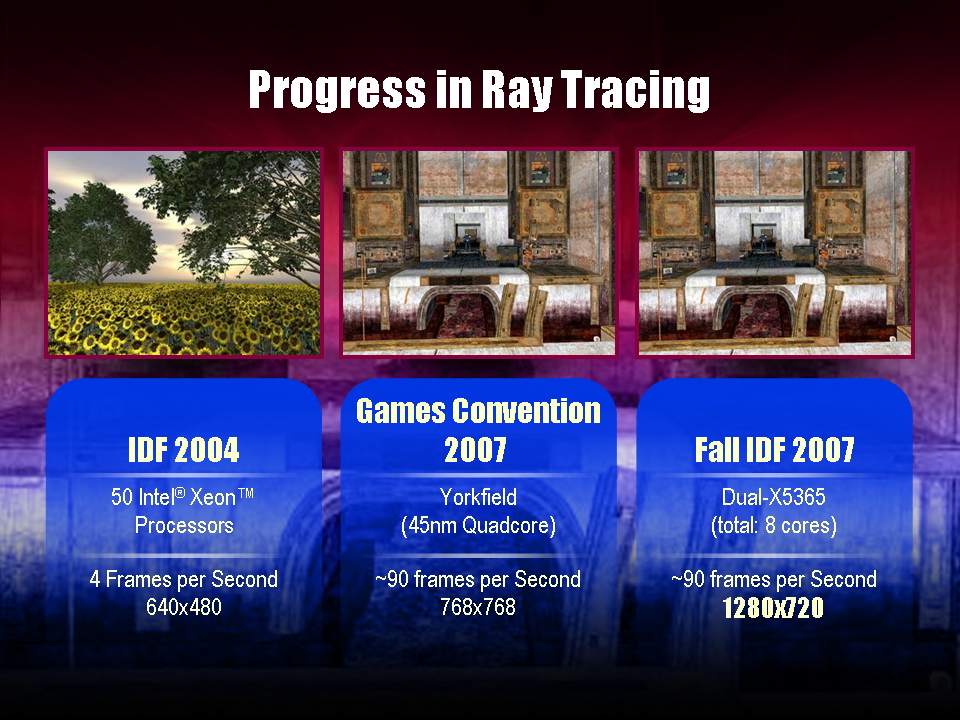When Will Ray Tracing Replace Rasterization?
Introduction
During the past few years, ray tracing seems to have become the El Dorado of the real-time 3D world. The rendering technique sparked a peak of interest when a young researcher by the name of Daniel Pohl devoted a research project to the technology in 2004.
The reason the general public took an interest in his work is largely because Pohl chose to focus on id Software's famous Quake III, Quake IV, and Quake Wars 3D shooter game franchise. The researcher got a lot of media coverage and gamers began dreaming of a bright future in which their favorite titles would be ray traced and devoid of rasterization.
Intel soon became aware of the buzz and spotted an ideal way to justify increasing the number of cores in its processors. The company quickly started its own research program and now never misses an opportunity to remind us that ray tracing is the future of real-time 3D games. But is it, really? What technical realities lie behind the marketing hype? What are the real advantages of ray tracing? Can we really expect it to replace rasterization? We'll try to provide some answers to those questions.
Get Tom's Hardware's best news and in-depth reviews, straight to your inbox.
-
IzzyCraft Greed? You give an inch they take a mile? Very pessimistic conclusion although it helps drive the industry so hard to really complain. ;)Reply -
Ramar I'm definitely the kind of person that would prefer to lose some performance in exchange for elegance and perfection. The eye can tell when something is done cheaply in a render. I've made this argument that quite often we find computationally cheap methods of doing something in a game, and after time it seems to me that we've got a 400 horsepower muscle car that, on close inspection, is held together with duct tape and dreams. I'd much rather have a V6 sedan that's spotless and responds properly.Reply
Okay, well in real life, the Half Life 2 buggy would be a lot cooler to drive around than a Jetta, but you get the analogy. -
zodiacfml i still like the simplicity of ray tracing and how close it is to physics/science. it is just how it works, bounce light to everything.Reply
there are a lot of diminishing returns i can see in the future, some are, how complex can rasterization can get? what is the diminishing returns for image resolution especially on the desktop/living room?
ray tracing has a lot of room for optimization.
for years to come, indeed, raster is good for what is possible in hardware. look further ahead,more than 5 years, we'll have hardware fast enough and efficient algorithm for ray tracing. not to mention the big cpu companies, amd & intel, who will push this and earn everyones money. -
stray_gator aargh. start typing, then sign in to find your first words posted.Reply
Anyway, what I liked about this article is its being under the hood, but not related to a new product, announcement or such.
"deep tech" articles accompanying product launches tend inevitably to follow the lines of press kits, PR slides, etc.
Articles like this, while take longer to research, are exactly that - they are researched rather than detailing "company X implemented techniques Y and Z in their new product, which works this way, benefits performance that way and is really cool.". it gives an independent, comprehensive view of the subject, and gives the reader real understanding in the field. -
enewmen The ray-tracing code on the business card was way cool. I was hoping (real-time)ray-tracing and photo-realistic rendering will come with DX11 and GPGPU offloading - this seems completely unrealistic.Reply
I still never read of any dedicated ray-tracing hardware, at any price. It seems the better we understand ray-tracing and it's limitations, the more cloudy the future becomes. -
LORD_ORION Ray tracing will inevtiably replace rasterization. It will just flat out look better to the human perception, when in motion, than pure rasterization, and that is all that is required.Reply
Heh... this article brought to you by Nvidia. -
annymmo Hopefully GPGPU (OpenCL)Reply
will make raytracing possible.
(Together with a huge number of processing cores per graphic card and an advanced raytracing algorithm.)
-
Inneandar nice article.Reply
I wouldn't mind having just a little bit more technical depth, but I'd be glad to seem more like this on Tom's.

